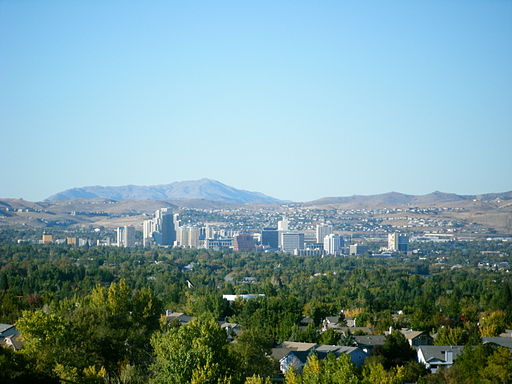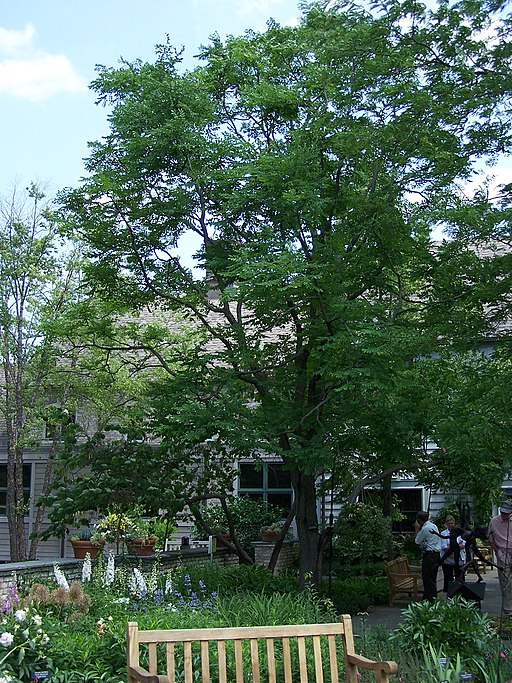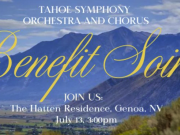A little earlier this year, we took a look at instances in which the city of Reno showed up in literature, and at the top of the list was The City of Trembling Leaves by Walter Van Tilburg Clark. Well, I don’t know much about trembling, but this is the time of year when the leaves are supposed to be turning, so it seems a good opportunity to discuss the Biggest Little City’s fall foliage. We do, after all, have an abundance of trees here compared to most of the rest of the state, particularly if you’re looking for trees with leaves rather than needles. It’s a fact recognized not only by Clark in 1945, but also by the Arbor Day Foundation, established in 1976, which has recognized Reno as being a Tree City USA, the first such recognition in the state, way back in 1983. Photo at left: Pixabay, Albrecht Fietz.
 In fact, the city can get pretty persnickety about the subject of trees. The Reno Urban Forestry Commission even has a list of what types of trees specifically can and cannot be planted on city property. The list of what trees are acceptable is heavy on a variety of maples and oaks as well as some flowering (but non-fruit-bearing) cherry and berry trees, among others. For the trees that make the naughty list, the city usually offers up a reason or two. For example, no conifers, because they throw too much shade in the winter and don’t allow for snow and ice to melt off. No fruit trees. No box elder, walnut, aspen, cottonwood, willow, elm and a whole slew of other species because of a range of reasons including invasive roots, susceptible to diseases, bugs, etc. Photo at right: Wikimedia Commons.
In fact, the city can get pretty persnickety about the subject of trees. The Reno Urban Forestry Commission even has a list of what types of trees specifically can and cannot be planted on city property. The list of what trees are acceptable is heavy on a variety of maples and oaks as well as some flowering (but non-fruit-bearing) cherry and berry trees, among others. For the trees that make the naughty list, the city usually offers up a reason or two. For example, no conifers, because they throw too much shade in the winter and don’t allow for snow and ice to melt off. No fruit trees. No box elder, walnut, aspen, cottonwood, willow, elm and a whole slew of other species because of a range of reasons including invasive roots, susceptible to diseases, bugs, etc. Photo at right: Wikimedia Commons.
 But just because the city won’t allow certain species of trees to be planted on city property doesn’t mean those types of trees don’t grow here in the area. In fact, the Truckee Meadows Parks Foundation has a list of local deciduous trees that includes quite a few of the ones banned by the city, including the quaking aspen, cottonwood, Russian olive (classified as an invasive species) and box elder. On the other hand, there are plenty of trees that can be seen growing locally and are on the approved list. I’ve got a background in forestry and I have to admit that some are species I wasn’t aware of, such as the Kentucky coffee tree. Photo at left, Wikimedia Commons, S.E. Wilco.
But just because the city won’t allow certain species of trees to be planted on city property doesn’t mean those types of trees don’t grow here in the area. In fact, the Truckee Meadows Parks Foundation has a list of local deciduous trees that includes quite a few of the ones banned by the city, including the quaking aspen, cottonwood, Russian olive (classified as an invasive species) and box elder. On the other hand, there are plenty of trees that can be seen growing locally and are on the approved list. I’ve got a background in forestry and I have to admit that some are species I wasn’t aware of, such as the Kentucky coffee tree. Photo at left, Wikimedia Commons, S.E. Wilco.
 But as far as the top-pick trees for fall foliage, your best bets are going to be the aspen and maples, and one that is popular in landscaped yards, the chanticleer pear. While the latter two can turn a nice deep red in the fall, it’s the shimmering gold autumn leaves of the aspen tinged with a brilliant orange that I like the best. I’ve always thought of the aspen as a Western tree, and while it’s true that they do well throughout the interior West, more or less within the Rocky Mountain corridor, the U.S. Forest Service lists their range as including much of the northern and northeastern United States, from the Great Lakes across to New England, and most of the northern third of North America from Alaska across Canada to the Atlantic. One of the reasons that the aspen is on the non-approved list from the city is that it has shallow, shared roots and doesn’t do great when it can’t get the water it needs. This attribute is why you’ll see the draws of the mountainsides (think about the drive up Mt. Rose Highway, for example) light up with gold and orange in the fall as the turning leaves set the aspens apart from the pines. Photo at right: Wikimedia Commons, F.A. Martin.
But as far as the top-pick trees for fall foliage, your best bets are going to be the aspen and maples, and one that is popular in landscaped yards, the chanticleer pear. While the latter two can turn a nice deep red in the fall, it’s the shimmering gold autumn leaves of the aspen tinged with a brilliant orange that I like the best. I’ve always thought of the aspen as a Western tree, and while it’s true that they do well throughout the interior West, more or less within the Rocky Mountain corridor, the U.S. Forest Service lists their range as including much of the northern and northeastern United States, from the Great Lakes across to New England, and most of the northern third of North America from Alaska across Canada to the Atlantic. One of the reasons that the aspen is on the non-approved list from the city is that it has shallow, shared roots and doesn’t do great when it can’t get the water it needs. This attribute is why you’ll see the draws of the mountainsides (think about the drive up Mt. Rose Highway, for example) light up with gold and orange in the fall as the turning leaves set the aspens apart from the pines. Photo at right: Wikimedia Commons, F.A. Martin.
And of course, aspen are known as quaking aspen, or “quakies.” I grew up on the explanation that it’s because of the shimmering appearance produced when a breeze passes through the leaves, but the Truckee Meadows Parks Foundation claims it’s because the leaves make a rustling sound in the wind. I tend to stick with my original interpretation, but either way, the quakie is a great way to tie back into the trembling leaves in the novel by Clark that started this whole conversation in the first place. Have a great start to your October and happy leaf peeping.


 R. Keith Rugg has worked on staff for a number of local publications, including Lake Tahoe Action Magazine, the Tahoe Daily Tribune and the Reno Gazette-Journal.
R. Keith Rugg has worked on staff for a number of local publications, including Lake Tahoe Action Magazine, the Tahoe Daily Tribune and the Reno Gazette-Journal.

